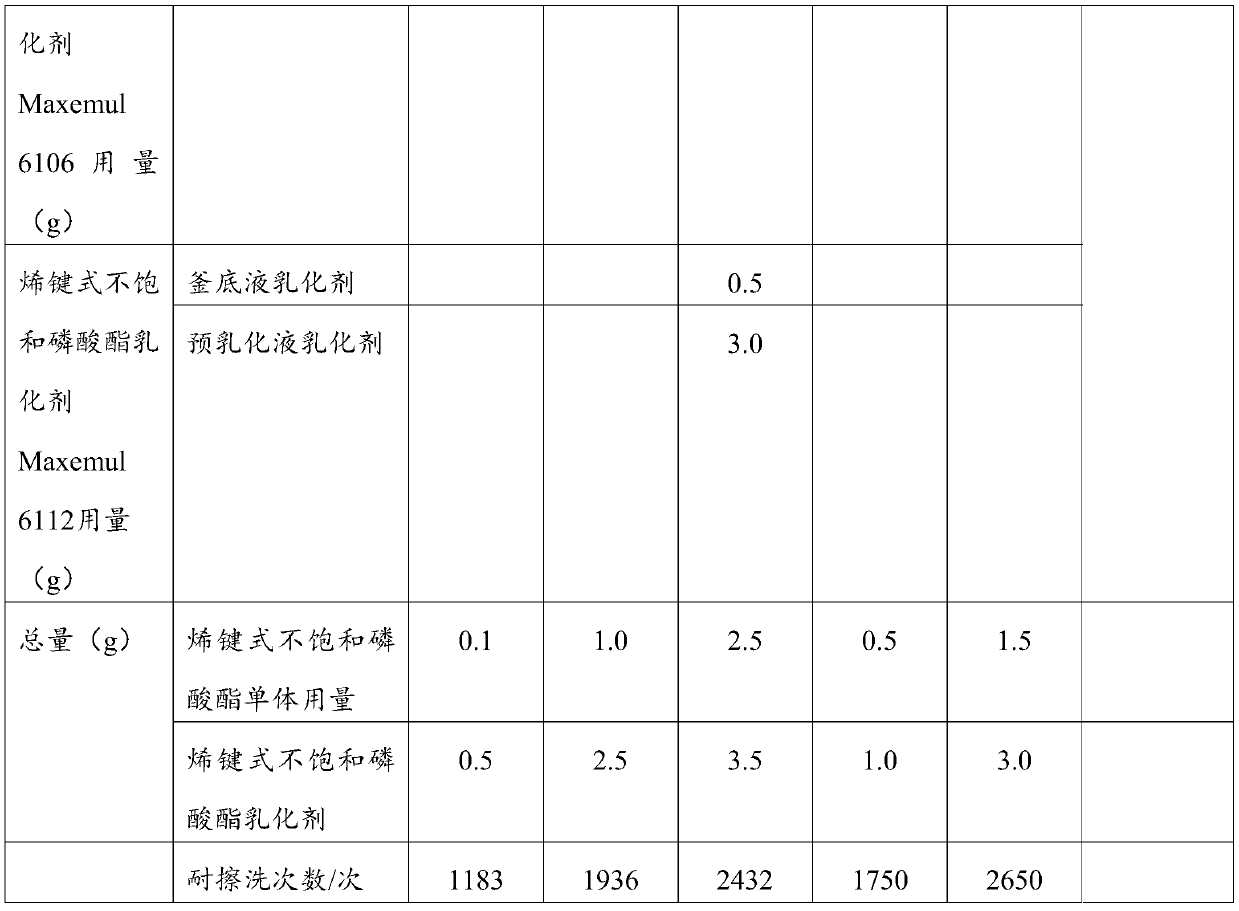Acrylate emulsion, preparation method and application thereof
An acrylate and emulsion technology, applied in latex paints, coatings, etc., can solve problems affecting scrub resistance, limited improvement of latex paint scrub resistance, affecting polymer adhesion, water resistance, freeze-thaw stability, etc.
- Summary
- Abstract
- Description
- Claims
- Application Information
AI Technical Summary
Problems solved by technology
Method used
Image
Examples
Embodiment 1
[0079]Weigh each raw material according to the following mass: styrene 40g, n-butyl acrylate 30g, acrylic acid 0.5g, acrylamide 2.0g, diacetone acrylamide 1.5g, SIPOMER PAM-100 0.1g, n-dodecyl mercaptan 0.01g , Maxemul 610 60.5g, ammonium persulfate 0.2g, tert-butyl hydroperoxide 0.1g, isoascorbic acid 0.05g and appropriate amount of NaOH and deionized water.
[0080] 1) Preparation of pre-emulsion A: under normal temperature and pressure, add 0.5g Maxemul 6106 and 35g deionized water into the pre-emulsification tank with monomer metering tank and agitator, stir well to dissolve, then add 40g styrene in turn , 30g n-butyl acrylate, 0.5g acrylic acid, 90% acrylamide (i.e. 1.8g acrylamide), 1.5g diacetone acrylamide and 0.1g SIPOMERPAM-100, fully stirred for 20-30 minutes for later use;
[0081] 2) Preparation of the bottom liquid B: add the remaining acrylamide (0.2 g of acrylamide) and 50 g of deionized water into the polymerization tank equipped with a stirrer, a condenser, a...
Embodiment 2
[0086] Weigh each raw material according to the following mass: styrene 51g, n-butyl acrylate 30g, isooctyl acrylate 10g, acrylic acid 2.0g, acrylamide 0.25g, diacetone acrylamide 0.75g, SIPOMER PAM-1001.0g, n-dodecane 0.05g of base mercaptan, 2.5g of Maxemul 6106, 0.5g of ammonium persulfate, 0.5g of tert-butyl hydroperoxide, 0.25g of isoascorbic acid and appropriate amount of NaOH and deionized water.
[0087] 1) Preparation of pre-emulsion A: under normal temperature and pressure, add 2.5g Maxemul 6106 and 35g deionized water into the pre-emulsification tank with monomer metering tank and agitator, stir well and dissolve, then add 51g styrene in turn , 30g n-butyl acrylate, 10g isooctyl acrylate, 2.0g acrylic acid, 90% acrylamide (ie, 0.23g acrylamide), 0.75g diacetone acrylamide and 1.0g SIPOMER PAM-100, stir well for 20-30 minutes spare;
[0088] 2) Preparation of bottom liquid B: Add the remaining acrylamide (ie, 0.02g acrylamide) and 60g deionized water into the polyme...
Embodiment 3
[0093] Weigh each raw material according to the following mass: styrene 70g, n-butyl acrylate 60g, acrylic acid 5.0g, diacetone acrylamide 0.1g, SIPOMER PAM-100 1.0g, SIPOMER PAM-4000 1.5g, n-dodecyl mercaptan 0.1g, Maxemul 6112 3.5g, ammonium persulfate 1.0g, tert-butyl hydroperoxide 1.0g, isoascorbic acid 0.5g and appropriate amount of NaOH and deionized water.
[0094] 1) Preparation of pre-emulsion A: under normal temperature and pressure, add 3.0g Maxemul 6112 and 55g deionized water to the pre-emulsification tank with monomer metering tank and agitator, stir well to dissolve, and then add 70g benzene Ethylene, 60g n-butyl acrylate, 5.0g acrylic acid, 0.1g diacetone acrylamide, 1.0g SIPOMER PAM-100 and 1.5g SIPOMER PAM-4000, fully stirred for 20-30 minutes and set aside;
[0095] 2) Preparation of still bottom liquid B: in the polymerization kettle with stirrer, condenser, constant flow pump feeding device, add remaining emulsifier Maxemul 6112 (that is, 0.5g Maxemul 6112...
PUM
 Login to View More
Login to View More Abstract
Description
Claims
Application Information
 Login to View More
Login to View More - R&D
- Intellectual Property
- Life Sciences
- Materials
- Tech Scout
- Unparalleled Data Quality
- Higher Quality Content
- 60% Fewer Hallucinations
Browse by: Latest US Patents, China's latest patents, Technical Efficacy Thesaurus, Application Domain, Technology Topic, Popular Technical Reports.
© 2025 PatSnap. All rights reserved.Legal|Privacy policy|Modern Slavery Act Transparency Statement|Sitemap|About US| Contact US: help@patsnap.com



